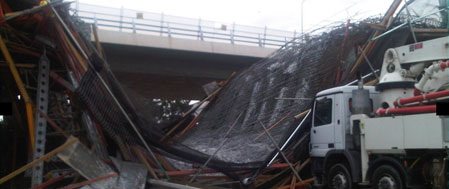
This year marks 10 years since the collapse of a section of the Gungahlin Drive Extension. Photo: File.
Most Canberrans will remember when a section of the Gungahlin Drive Extension collapsed due to engineering failures.
On 14 August, it will be 10 years since the incident that, remarkably, did not result in a loss of life when a section of the bridge under construction collapsed adjacent to an existing bridge.
Nine people were taken to Canberra Hospital with injuries ranging from limb lacerations to suspected spinal injuries. One man was left suspended in mid-air for about 15 minutes after he grabbed hold of a cement truck hose until rescued by firefighters. A further 15 patients were assessed on scene by intensive care paramedics.

The collapse of the GDE in 2010. Photo: File.
The incident occurred when more than 800 tonnes of concrete was being poured onto the span of the new bridge.
The collapse raised significant issues relating to the design and suitability of temporary works used in the construction of road infrastructure.
READ MORE: Building industry call for government boost as confidence collapses
WorkSafe ACT deemed it necessary that a thorough, independent investigation occur into the technical causes and circumstances of the bridge collapse.
An engineers’ report, commissioned by the ACT Government, also found that structural and planning failures led to the accident.
Despite damning findings by other reports, WorkSafe decided that charges would not be laid.
“This, in part, was due to the length of time taken on the investigation by WorkSafe ACT which would have inhibited prosecuting this matter successfully,” a WorkSafe ACT spokesperson said in 2016.
Since then, several major reports have recommended implementing an engineer registration scheme to ensure only those who are appropriately qualified and skilled can work as engineers.
In September 2012, then ACT Attorney-General Simon Corbell commissioned the Getting Home Safely Report in the wake of three deaths in the construction industry within a year and a high number of other serious safety incidents.
Last week, the Barr Government made a commitment to introducing an engineer registration scheme for the ACT in the coming term of government if elected.

Director of the ACT Branch of Professionals Australia Dale Beasley. Photo: Supplied.
The director of the ACT Branch of Professionals Australia, the union for Australian engineers, Dale Beasley, told Region Media he welcomed the pre-election commitment, but Canberrans would be shocked to learn the ACT still has no system that ensures engineers are properly qualified or their skills are kept up to date.
“It’s an extraordinary regulatory loophole that does not exist in other professions which impact on public safety like electricians, plumbers and architects,” Mr Beasley said.
“The introduction of an engineer registration scheme will ensure that only properly qualified and skilled engineers are permitted to work in the ACT, enhancing safety and reducing economic waste associated with cost overruns and delays due to poor scoping.”
With more than $3 billion flagged for infrastructure spending during the next four years, including new schools, healthcare facilities, public housing and transport, Mr Beasley says the next ACT Government has much to lose if it fails to get this right.
“That’s why we’re calling on the ACT Greens, Canberra Liberals and all candidates to commit to implementing an engineer registration scheme in the next term of government if elected.”
Mr Beasley said the fact that anyone can work as an engineer in the ACT makes the Territory a destination of last resort for thousands of unqualified engineers who can no longer practice elsewhere. He said Queensland, Victoria and NSW all require registration and the Canberra community will ultimately bear the increased cost and safety risks by not being in lock-step with other states.
“The tender process itself lends to corners being cut from trying to get the tender as low as possible. It also well established throughout the building industry that project costs routinely blow out to the order of 6 to 12 per cent due to a lack of engineering expertise being put in at critical points of the process,” he said.
“There are a litany of reports that show the early input of engineering expertise helps to make sure that projects are delivered on time and on budget, and most importantly, safely.
“We’ve seen plenty of recent instances of problems with apartment builds in Canberra, but the real problem is that it can take something to go wrong to find out where the real problems are.”
Mr Beasley also said the cost of registration for engineers (about $300 in Queensland) more than offsets the risk of having rogue engineers operating with the 6000 engineers working in Canberra.
“Other states have taken quantum leaps in terms of their reforms, but the ACT is playing catch-up in terms of its progress from a report that was handed down in 2012, as well as other reports since.
“We welcome the current government’s commitment to introduce a registration scheme, but this is another election commitment that follows the one we had previously. We really want to see the rubber hitting the road.”













